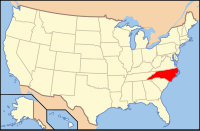Mecklenburg County, North Carolina
| Mecklenburg County, North Carolina | |||
|---|---|---|---|

|
|||
|
|||
 Location in the U.S. state of North Carolina |
|||
 North Carolina's location in the U.S. |
|||
| Founded | November 6, 1762 | ||
| Named for | Charlotte of Mecklenburg-Strelitz | ||
| Seat | Charlotte | ||
| Largest city | Charlotte | ||
| Area | |||
| • Total | 546 sq mi (1,414 km2) | ||
| • Land | 524 sq mi (1,357 km2) | ||
| • Water | 22 sq mi (57 km2), 4.0% | ||
| Population (est.) | |||
| • (2015) | 1,034,070 | ||
| • Density | 1,932.3/sq mi (746/km²) | ||
| Demonym(s) | Mecklenburger | ||
| Congressional districts | 9th, 12th | ||
| Time zone | Eastern: UTC-5/-4 | ||
| Website | www |
||
Mecklenburg County is a county located on the border in the southwestern part of the state of North Carolina, in the United States. As of the 2010 census, the population was 919,628. It increased to 1,034,070 as of the 2015 estimate, making it the most populated county in North Carolina. Its county seat and largest city is Charlotte.
NOTE: To see information about the political body, the 'Mecklenburg County Commission' see this link: Mecklenburg County Commission.
Mecklenburg County is included in the Charlotte-Concord-Gastonia, NC-SC Metropolitan Statistical Area.
On September 12, 2013, the county welcomed its one millionth resident.
Mecklenburg County was formed in 1762 from the western part of Anson County, both in the Piedmont section of the state. It was named in commemoration of the marriage of King George III to Charlotte of Mecklenburg-Strelitz, for whom the county seat Charlotte is named. Due to unsure boundaries, a large part of south and western Mecklenburg County extended into areas that would later form part of the state of South Carolina. In 1768, most of this area (the part of Mecklenburg County west of the Catawba River) was designated Tryon County, North Carolina.
Determining the final boundaries of these "western" areas between North and South Carolina was a decades-long process. As population increased in the area following the American Revolutionary War, in 1792 the northeastern part of Mecklenburg County was taken by the North Carolina legislature for Cabarrus County. Finally, in 1842 the southeastern part of Mecklenburg County was combined with the western part of Anson County to become Union County.
...
Wikipedia


